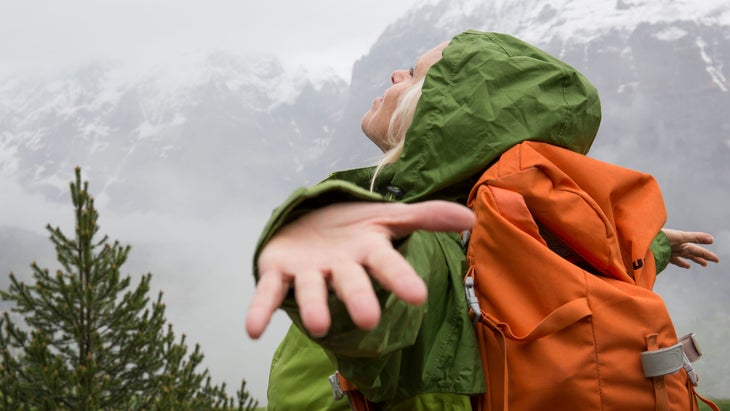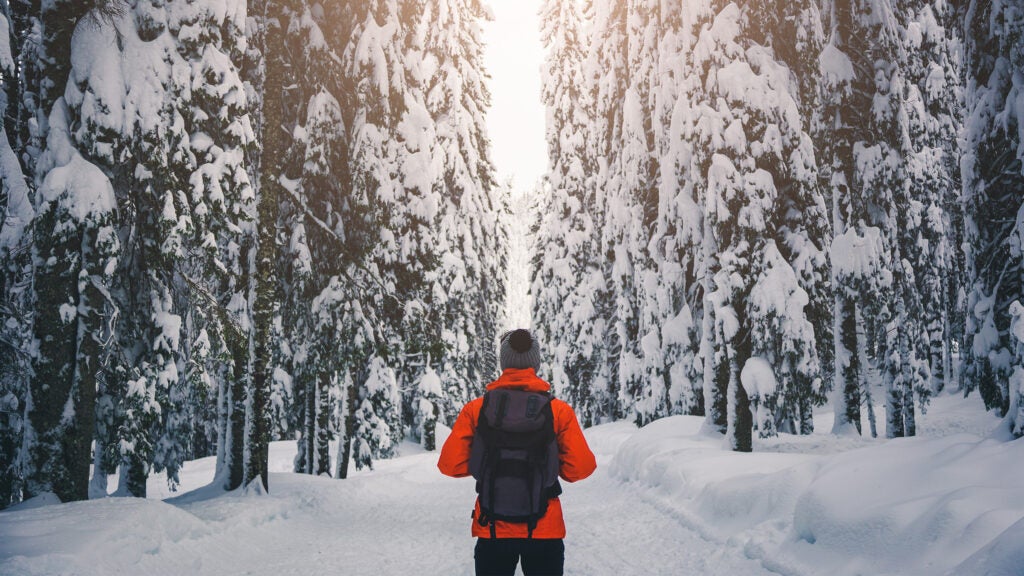Products You May Like
As a southern belle who grew up in Georgia, I was never much good at being cold. The first time I went winter camping, I got hypothermia. I was too cheap to buy winter pants and wore four pairs of leggings instead. In this getup, I hiked up a mountain, soaked myself in sweat, and started shivering as soon as night fell. My hiking partners had to take turns feeding me peanut butter cups and rotating me around the fire like a rotisserie chicken until I warmed up.
Because I survived—and conflated this with success at winter camping—I decided to move from my sweltering, swampy Georgia home to the Colorado mountains. In December.
Never having driven on real ice, my brother and I did a full 360 on a patch of it in Kansas, white-knuckling the sides of our seats as we slid to a stop on the other side of the empty highway. A month later, I crashed my car trying to drive in the mildest of slush. On New Year’s Eve, I went sledding (because that’s what I thought snow-loving people were supposed to do) and almost certainly broke my tailbone slamming into a rock at full speed on a flattened pizza box. As I was waddling from the sledding hill to the bar, my hands went numb, and I cried.
From that moment on, I was convinced that I would never be good at being cold. My entire first winter in Colorado seemed to confirm this. The minute goosebumps appeared on my arms, I would suddenly become sad and agitated. I would sit down in the snow and cry. For a while, I thought I must have Seasonal Affective Disorder, or maybe some deeply repressed childhood trauma that was triggered by the sight of snow. It took me about a year to realize I was confusing cold for an emotion.
This epiphany came to me at the bottom of an ice climb that my then-boyfriend had convinced me to try. I was sitting on the ground, rocking back and forth, and ugly-crying into a frozen Clif Bar. He asked me if I hated ice climbing. I shook my head. I was actually really into ice climbing. So then why was I weeping snot all over my gloves?
Oh, wait. I realized. I’m not upset. I’m just cold. So, as part of my lifelong quest to make myself more pleasant to spend time with outdoors, I set out to fix this. I figured that if I could keep my hands from going numb, I would cry less. Ergo, more people would want to hang out with me.

I bought mittens. Then I bought real pants that were neither layered leggings nor 90s-era maternity ski bibs handed down from my mother. I started wearing a hat. I started drinking hot tea. And in the process, I discovered something life-changing: Being good at being cold isn’t a matter of character, genetic predisposition, or physical hardiness. It’s a learned skill. And it’s one anyone can learn, no matter what kind of swamp they grew up in. (Case in point: I—weepy, goosebumpy, southern belle that I am—went on to become a decent backcountry skier and competitive ice climber.)
Here’s how I tricked myself into learning to like cold weather.
- Fudge the truth. Winter sports can sound intimidating. “Winter hiking,” “winter camping,” and “mountaineering” all sound like scary activities that people who are not me like to do. So, when I’m trying to convince myself to do something I know will be a good time if I can just get my ass out the door, I don’t use these terms. Instead, I tell myself I’m “going to go for a romp” or “going to play outside in the snow.” Because, at the end of the day, that’s the whole point. And the reframe seems to take the pressure off.
- Never start cold. The hardest part of any winter hike is getting out of your warm car at the trailhead. That’s because many of us hikers have been deluded into thinking we should “start cold.” Sure, in theory, starting your hike in nothing but your baselayers will save you a layer-down stop in the first two miles. But in practice, it just makes the start of your hike miserable. Instead, I put on all my clothes in the car. Then, I crank the heat and I don’t leave the car until I’m so hot I can’t stand it (but before I get sweaty). By the time I step onto the trailhead, the cold feels refreshing, not antagonistic. Everything’s relative, right?
- Manage your layers religiously.The easiest way to convince yourself it’s not cold out is to never let yourself actually get cold. First, commit to delayering as soon as you break a sweat. (Wet clothes lead to hypothermia.) Then, when you stop to rest or snack, put on your big puffy immediately, even if you feel warm. Your body will cool off faster than you think, and you want to trap in the heat you generated while hiking for as long as possible.
- Bring a giant Thermos. It’s hard to remember to drink water in the winter, but hydration is critical for keeping your muscles lubricated and blood flowing. This will prevent you from getting cold, injured, or cranky. Even if I’m putting down tons of vert on a winter hike, I’ll always bring a heavy insulated bottle full of hot tea. It’s worth the weight every time.
- Eat a lot of chocolate. When you eat too little, your body runs out of energy. If you want to do winter sports, you have to eat a lot. This is non-negotiable. I recommend prioritizing carbs and fats. Carbs provide a burst of energy and warmth, and fats provide a long, slow burn that will keep you from crashing. Pack tons of food, and make sure it’s all stuff you love. (Pizza, peanut butter pretzels, pocket bacon, Snickers bars, and chocolate all top my list.) Fun food is an easy way to make a hike more entertaining. Plus, you’re way more likely to fuel consistently if you have snacks you actually like.
- Bring three pairs of gloves. For me, warm hands are the secret to hiking happy. I always bring at least two pairs of gloves in case one gets wet, in addition to a pair of big, fluffy mittens that I keep in a dry bag with my emergency puffy. If my fingers get chilly or numb, I stop immediately. I put on a jacket to hold the warmth in my arms, then I put my hands in my armpits, bare fingers next to skin. I keep them there until they’re not just lukewarm, but very warm. Then I put on my big mitts, keep moving, and don’t switch back into gloves until my hands are fully toasty. I’ve saved many a winter hike this way.
- Wear thinner socks. This one might sound counter-intuitive, but it’s the single most game-changing thing I’ve learned. When your shoes are too tight or your socks are too thick, they inhibit your circulation. Even a light squeeze of your feet can be enough to push the hot blood out of them—which will leave your toes numb in a heartbeat. No matter how cold it is, I always wear a thin, merino wool sock with zero padding. If it’s well below freezing, I’ll wear a warmer boot, but I never wear a thicker sock.
- Bring your funny friends. There’s a reason ski-mo competitors and ultra runners wear tu-tus and Hawaiian shirts to big races: The best way to forget you’re doing something that sucks is to embrace the ridiculousness of it all. Goofy people are good for that. If I’m going on an all-day adventure and expect to be cold, wet, or awake too early, I invite the funniest folks I know. We blast music in the car to psych ourselves up. Sometimes we wear costumes. Sometimes we hike in our sports bras and howl just to keep ourselves laughing. Before we know it, the sun’s up and we’re on top of something beautiful. And, more often than not, we have it all to ourselves.
